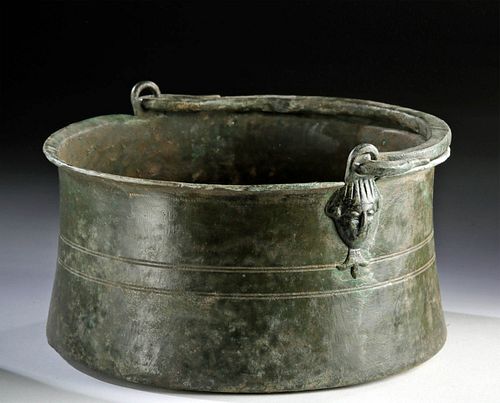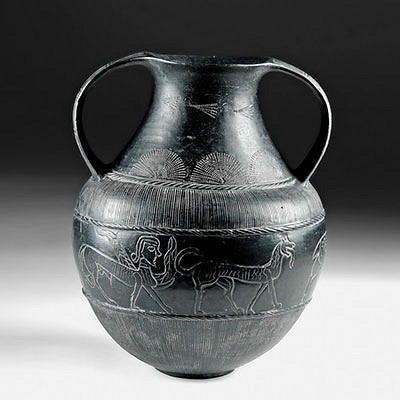Roman Brass Handled Situla w/ Maskette Attachments
Lot 33
About Seller
Artemis Fine Arts
686 S Taylor Ave, Ste 106
Louisville, CO 80027
United States
Selling antiquities, ancient and ethnographic art online since 1993, Artemis Gallery specializes in Classical Antiquities (Egyptian, Greek, Roman, Near Eastern), Asian, Pre-Columbian, African / Tribal / Oceanographic art. Our extensive inventory includes pottery, stone, metal, wood, glass and textil...Read more
Categories
Estimate:
$2,000 - $3,000
Absentee vs Live bid
Two ways to bid:
- Leave a max absentee bid and the platform will bid on your behalf up to your maximum bid during the live auction.
- Bid live during the auction and your bids will be submitted real-time to the auctioneer.
Bid Increments
| Price | Bid Increment |
|---|---|
| $0 | $25 |
| $300 | $50 |
| $1,000 | $100 |
| $2,000 | $250 |
| $5,000 | $500 |
| $10,000 | $1,000 |
| $20,000 | $2,500 |
| $50,000 | $5,000 |
| $100,000 | $10,000 |
| $200,000 | $20,000 |
About Auction
By Artemis Fine Arts
Sep 17, 2020
Set Reminder
2020-09-17 10:00:00
2020-09-17 10:00:00
America/New_York
Bidsquare
Bidsquare : CLEARANCE - Ancient, Pre-Columbian, Ethno Art
https://www.bidsquare.com/auctions/artemis-gallery/clearance---ancient-pre-columbian-ethno-art-5605
End-of-Summer Clearance sale featuring discounted pricing on antiquities from Egypt, Greece, Italy, and the Near East...plus Viking, Asian, Pre-Columbian, Tribal, Russian Icons, Spanish Colonial, Fine Art, more! Starting prices have been reduced up to 65% from original auction prices. Artemis Fine Arts info@artemisgallery.com
End-of-Summer Clearance sale featuring discounted pricing on antiquities from Egypt, Greece, Italy, and the Near East...plus Viking, Asian, Pre-Columbian, Tribal, Russian Icons, Spanish Colonial, Fine Art, more! Starting prices have been reduced up to 65% from original auction prices. Artemis Fine Arts info@artemisgallery.com
- Lot Description
**Originally Listed At $1200**
Roman, Imperial Period, ca. 1st to 3rd century CE. An attractive cast-brass situla with a flat base, concave walls which flare gently outward towards the top and dramatically at the lip, and a pair of riveted maskette-shaped attachments with attachment loops above. The arching handle is adorned with hammered circles on one side, with terminals threaded through the loops and then back again on themselves. Two thin pairs of incised striations course around the exterior of the situla and imbue the vessel with a personalized presentation. The situla was originally created for cooling and serving wine at banquets; others were used to hold ashes, or were buried with offerings in tombs. Size: 8.875" W x 4.875" H (22.5 cm x 12.4 cm); 8.5" H (21.6 cm) with handle raised.
As in Greece, masks played an important role in Roman theatre. An actor's entire head and hair would be covered by a large mask of simple design, made from linen or cork, with holes for the mouth and eyes. These masks allowed audience members seated in all areas of the theatre to understand what was happening, while also amplifying the actor's voice. The Pompeiian mosaic from the House of the Tragic Poet (now in the Naples National Archaeological Museum) shows several examples of these masks including one actor wearing one pushed up on his head. Mask motifs on decorative art as well as utilitarian objects speak to the power and popularity of Roman theatre.
Provenance: private East Coast, USA collection; ex-Richard Wagner collection, Cape Cod, Massachusetts, USA, acquired in the 1960s
All items legal to buy/sell under U.S. Statute covering cultural patrimony Code 2600, CHAPTER 14, and are guaranteed to be as described or your money back.
A Certificate of Authenticity will accompany all winning bids.
We ship worldwide and handle all shipping in-house for your convenience.
#145861Repair to several areas of base, with possible restoration, and resurfacing over break lines. Slight bending to overall form of rim, attachment loops, and handle, with fading to some finer details on handle, and light encrustations. Nice earthen deposits as well as great green and brown patina throughout.Condition
- Shipping Info
-
All shipping is handled in-house for your convenience. Your invoice from Artemis Gallery will include shipping calculation instructions. If in doubt, please inquire BEFORE bidding for estimated shipping costs for individual items.
-
- Buyer's Premium



 EUR
EUR CAD
CAD AUD
AUD GBP
GBP MXN
MXN HKD
HKD CNY
CNY MYR
MYR SEK
SEK SGD
SGD CHF
CHF THB
THB
















